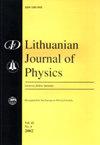Br-H和Br-Br键合Br4Py分子的自组装模型
IF 0.3
4区 物理与天体物理
Q4 PHYSICS, MULTIDISCIPLINARY
引用次数: 1
摘要
基于分子间卤素-氢(Br–H)和卤素-卤素(Br-Br)的成对键合,提出了一个模型来描述Br4Py分子自组装成两种不同的平面结构(第一阶段和第二阶段)。用密度泛函理论计算了两分子团簇和四分子团簇的成键相互作用。结果表明,约60%的结合强度是由静电Br(顶部)-Br(带)相互作用引起的,而其余的则是由Br–H相互作用引起。所获得的对相互作用的值被进一步用于蒙特卡罗计算。这些计算的模型是在正方形晶格上提出的。第一阶段有序的出现需要两个主要的配对相互作用,而第二阶段有序是使用单个相互作用获得的。所获得的结果解释了这两个阶段的出现。本文章由计算机程序翻译,如有差异,请以英文原文为准。
Model for self-assembly of Br–H and Br–Br bonded Br4Py molecules
A model, based on the pairwise intermolecular halogen–hydrogen (Br–H) and halogen–halogen (Br–Br) bonding, is proposed to describe the self-assembly of Br4Py molecules into two different planar structures (Phase I and Phase II). The pair bonding interactions are calculated by the density functional theory for the two-molecule and four-molecule clusters. It is shown that about 60% of bonding strength is due to the electrostatic Br(top)–Br(belt) interactions, while the remaining originates from Br–H interactions. The obtained values of pair interactions are further used for Monte Carlo calculations. The model for these calculations is proposed on a square lattice. The two main pair interactions are needed for the emergence of the Phase I ordering, while the Phase II ordering is obtained using a single interaction. The obtained results explain the emergence of both phases.
求助全文
通过发布文献求助,成功后即可免费获取论文全文。
去求助
来源期刊

Lithuanian Journal of Physics
物理-物理:综合
CiteScore
0.90
自引率
16.70%
发文量
21
审稿时长
>12 weeks
期刊介绍:
The main aim of the Lithuanian Journal of Physics is to reflect the most recent advances in various fields of theoretical, experimental, and applied physics, including: mathematical and computational physics; subatomic physics; atoms and molecules; chemical physics; electrodynamics and wave processes; nonlinear and coherent optics; spectroscopy.
 求助内容:
求助内容: 应助结果提醒方式:
应助结果提醒方式:


